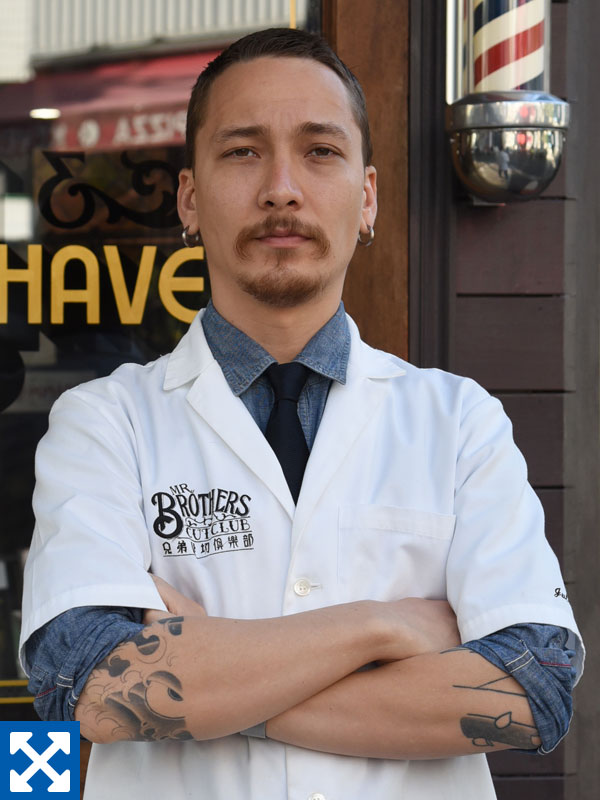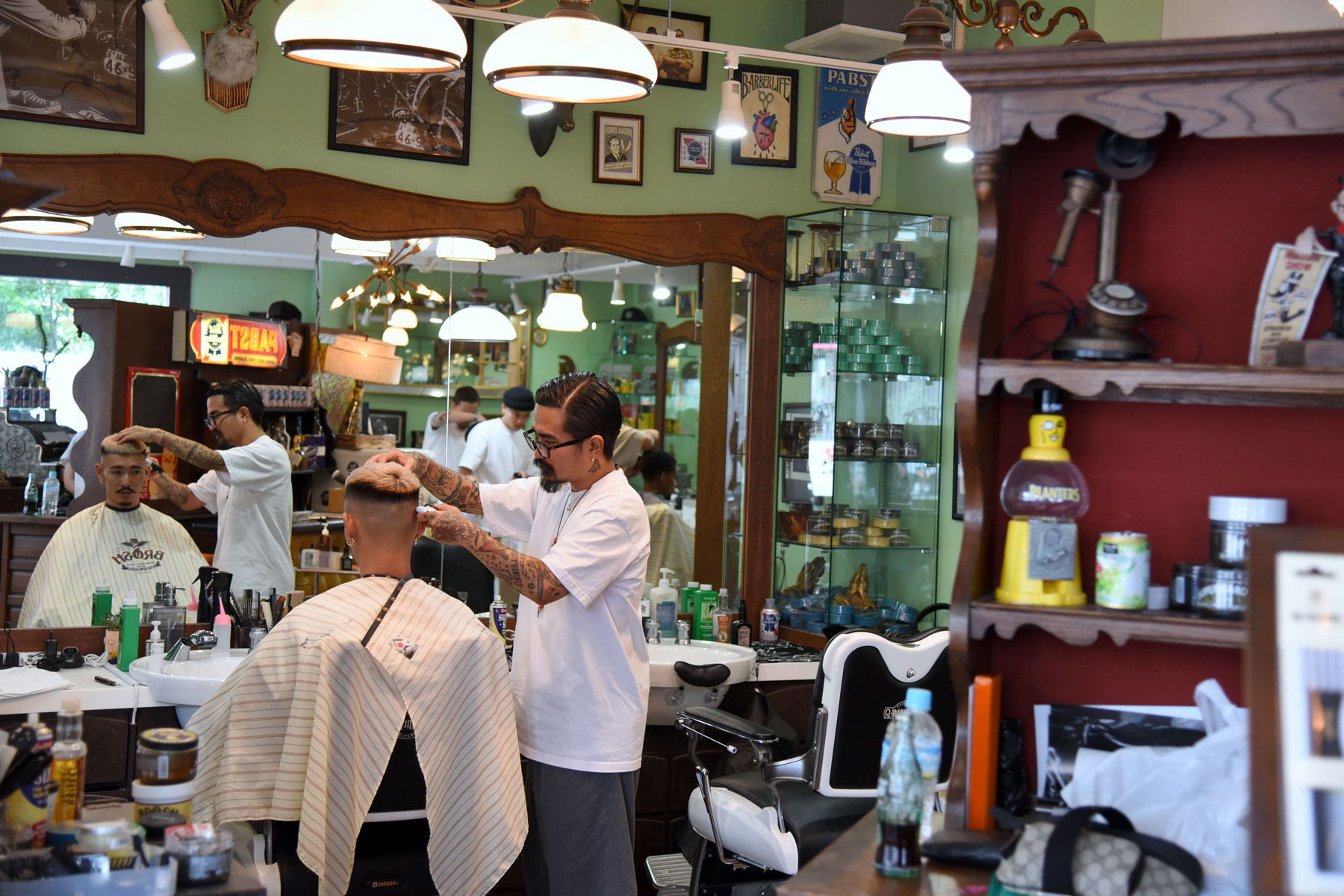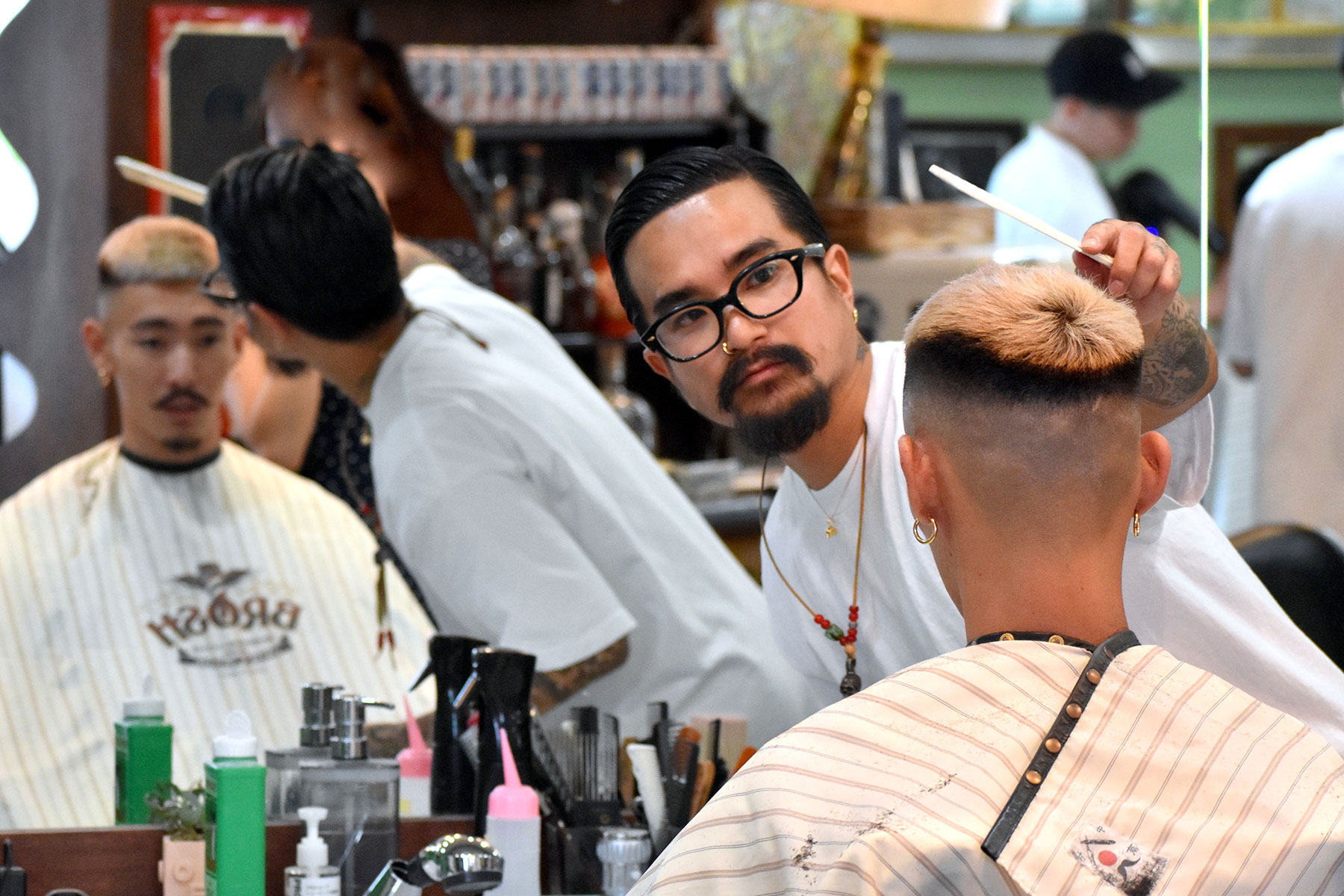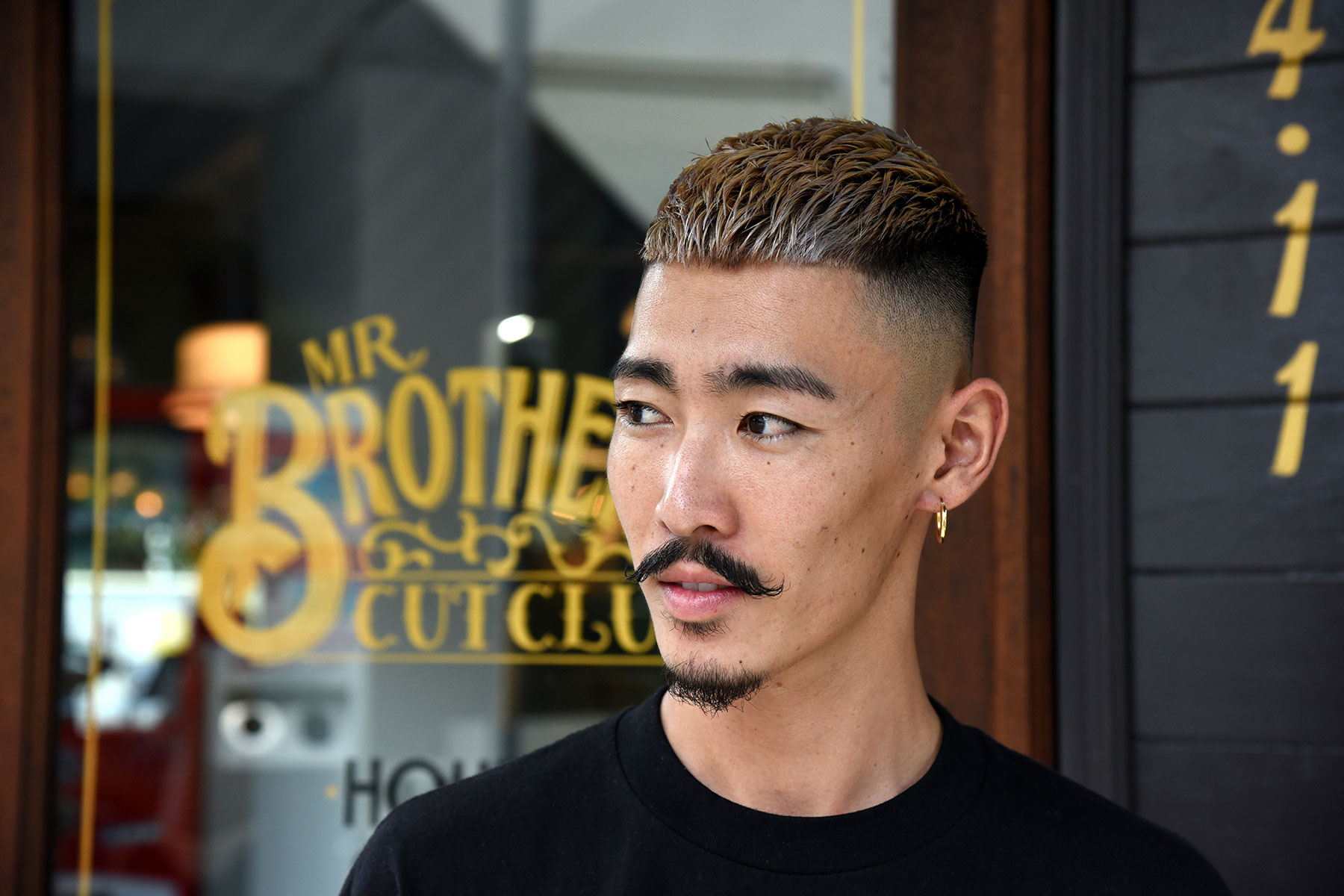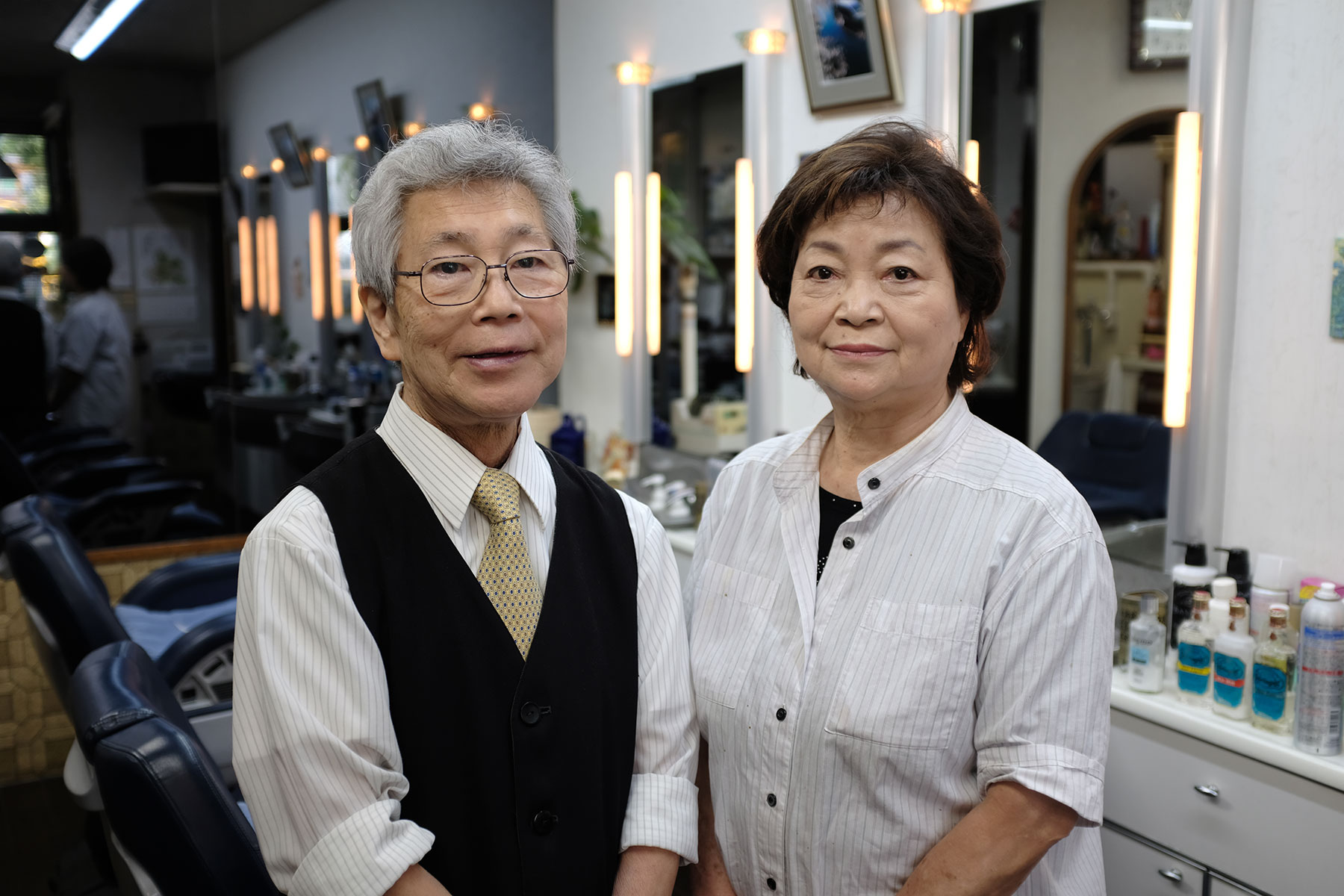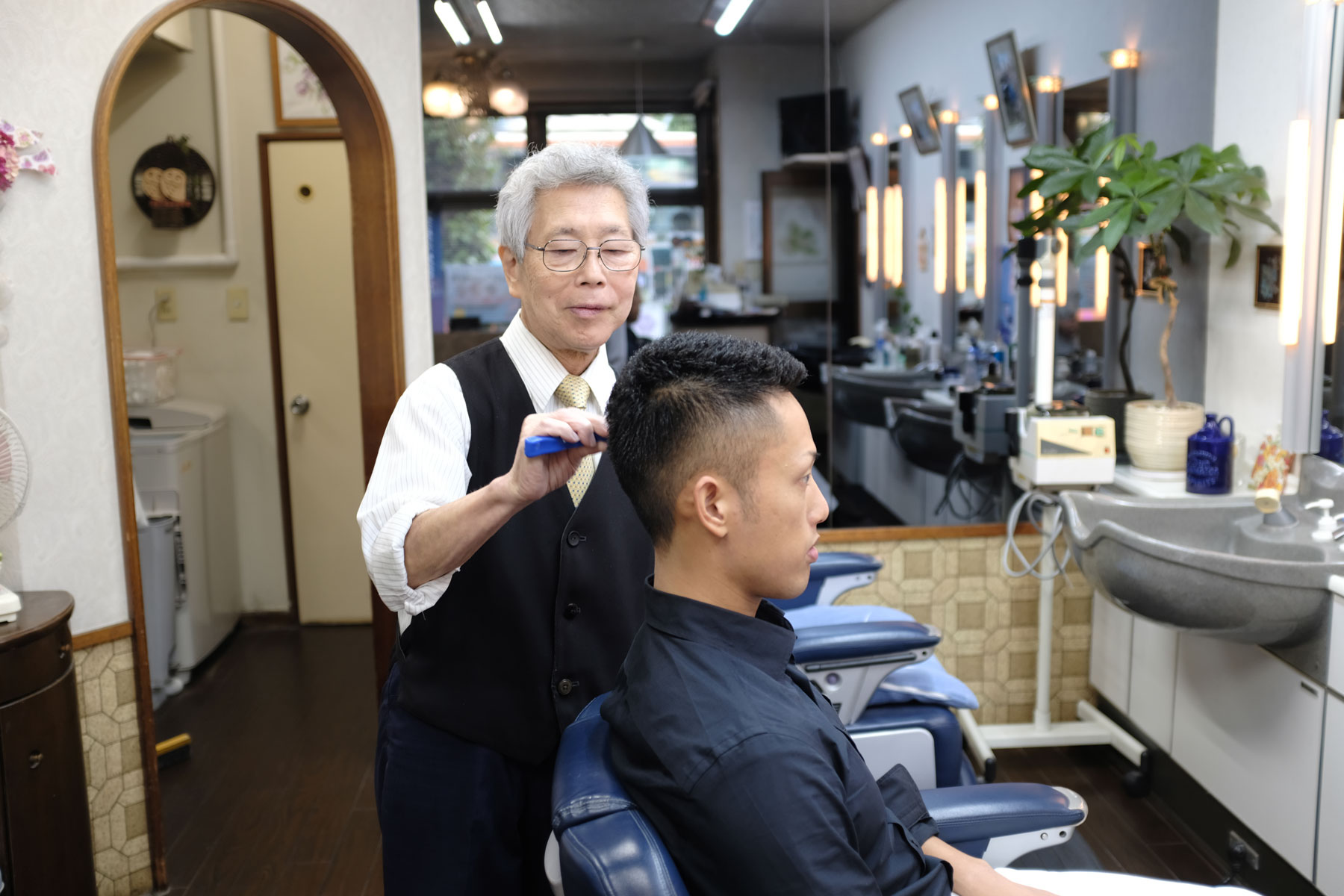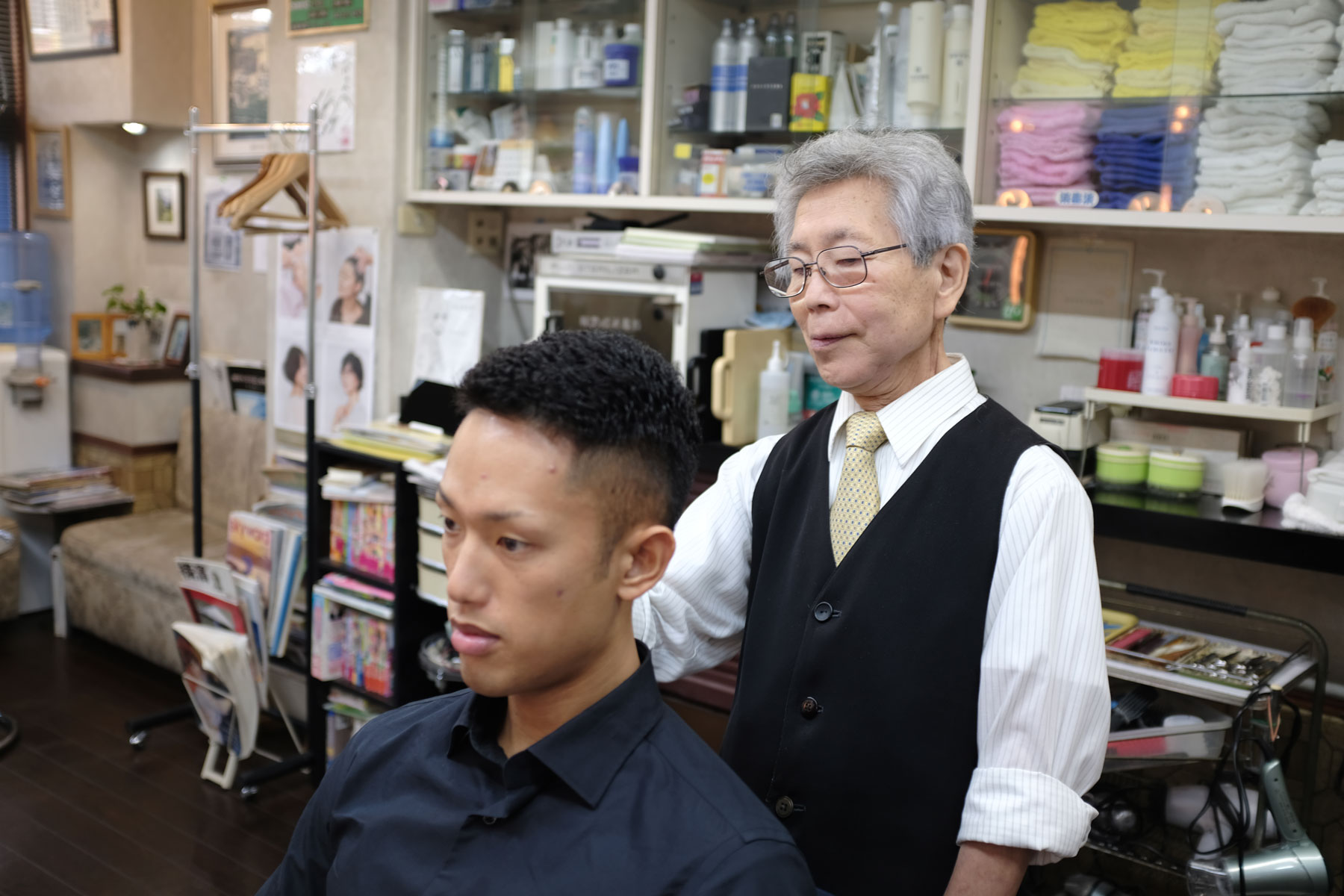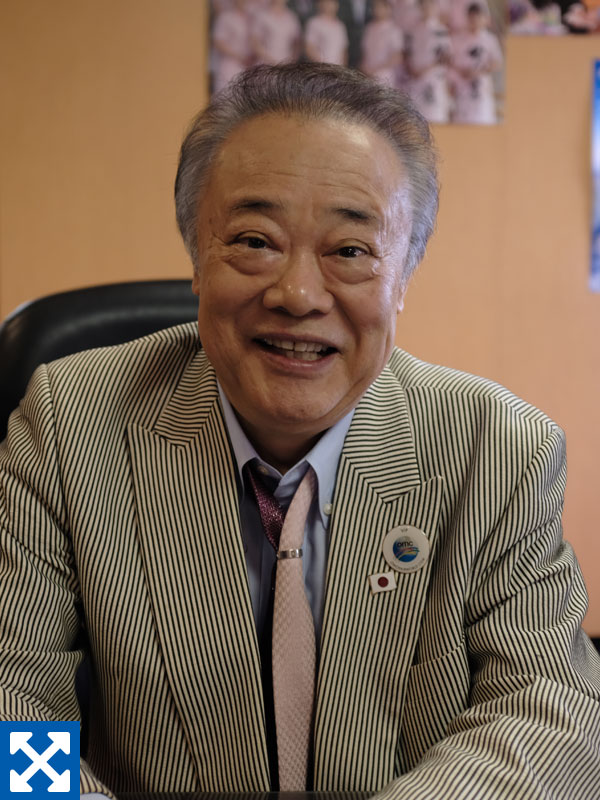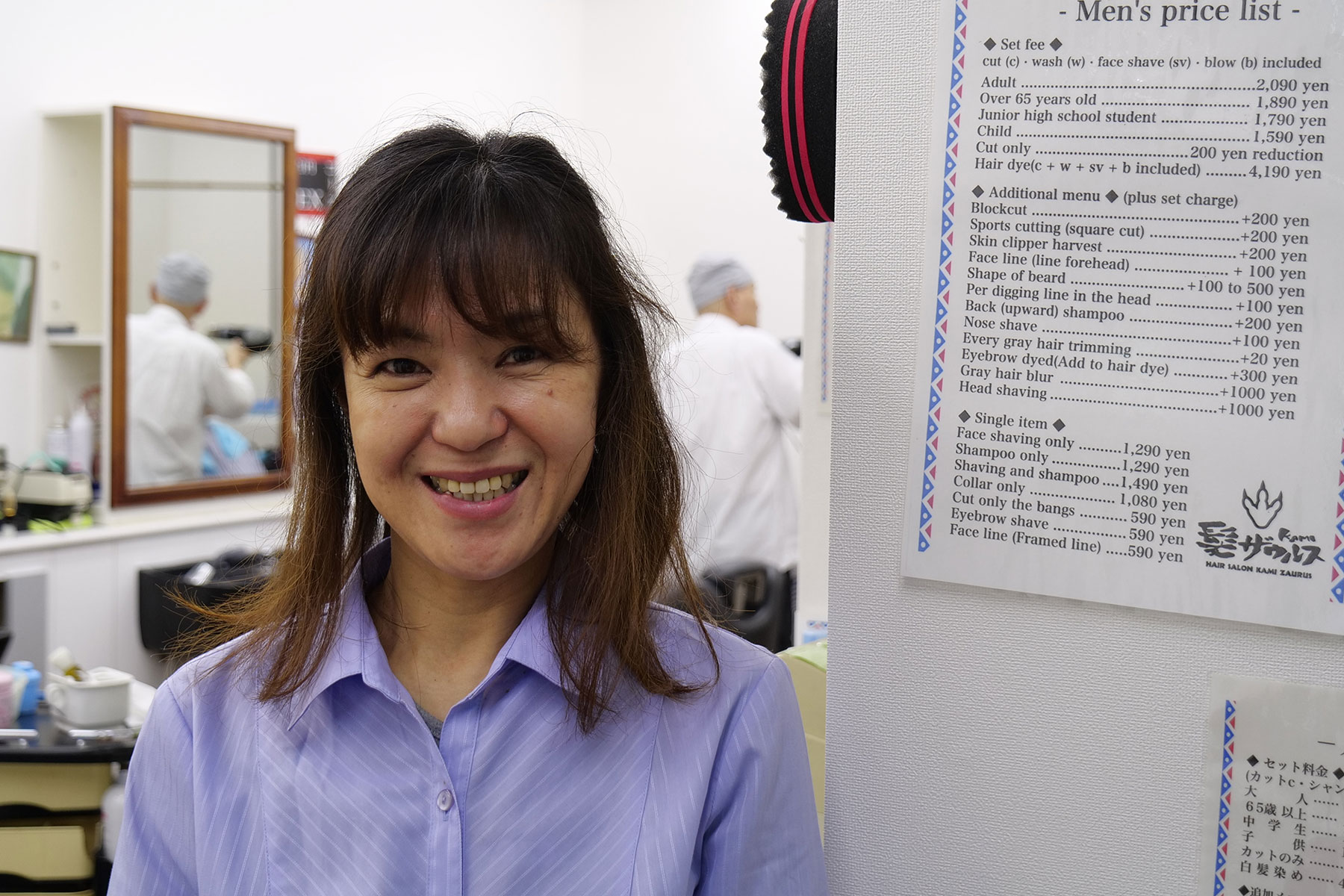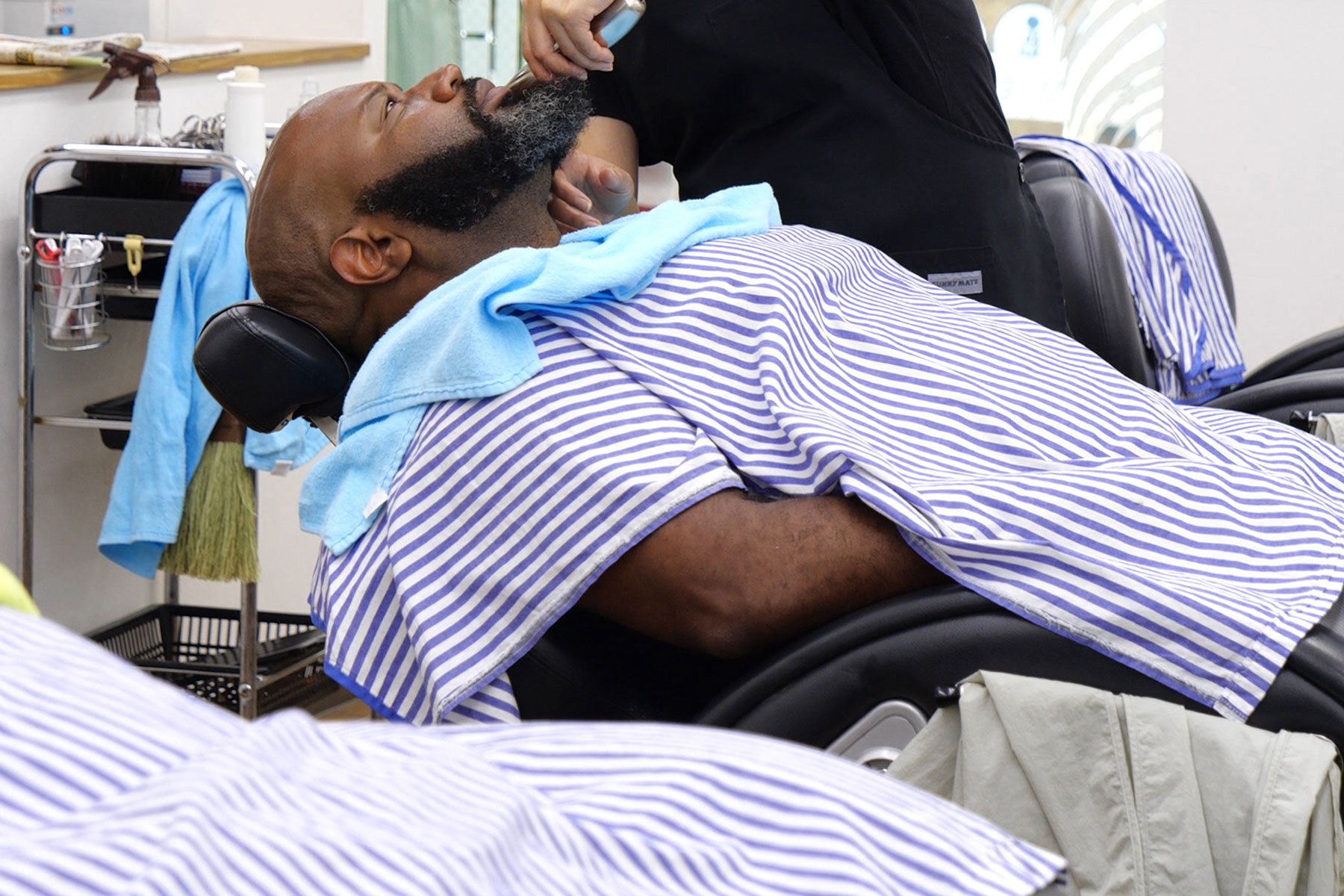Tomoya Nishimori, a barber at Mr. Brothers Cut Club, strives to change young people’s perception of barbershops in order to breathe life back into the industry. SATOKO KAWASAKI
A new generation of barbers is trying to overcome an image problem in a bid to rejuvenate business
TOMOHIRO OSAKI
Staff writer
A group of men sporting tattoos and smoking cigarettes chats casually on benches outside Mr. Brothers Cut Club in Tokyo’s trendy Harajuku neighborhood.
Were it not for a couple of red, white and blue barber’s poles hanging near the entranceway, a passerby might think they’ve simply stumbled upon some kind of uber-cool hipster hangout.
The truth isn’t actually too far off the mark.
Even once you step inside, Mr. Brothers’ bar-style interior bears little resemblance to the conventional Japanese barbershop typically run by couples in their twilight years.
Adorned with vintage furniture, photographs of motorcycles and empty cans of Pabst Blue Ribbon, Mr. Brothers feels every bit as rebellious as the heavily inked barbers working there.
“Our concept is ‘a barbershop you’ve never seen in Japan,’” says Julian Adler, one of Mr. Brothers’ founding members.
“Customers only interact with their barber in front of the mirror in a traditional Japanese barbershop, but here we chat on sofas and even step outside to smoke cigarettes together,” says Adler, 31. “This kind of socialization is pretty common overseas and is also an important part of our job.”
Mr. Brothers prides itself on having imported a new wave of barbering culture that — while relatively common in the West — is difficult to find in Japan.
The Harajuku-based store is one of a growing number of barbershops that have attracted youth in Japan through a deft makeover campaign on social media that promotes barbershops as something that’s cool.
“Cool” is not a word that is commonly used to describe barbers in Japan. Many traditional barbershops are aging and barely keeping their businesses afloat, outshone by rival beauty salons in the industry that are more often associated with a contemporary air of charisma and success.
Acutely aware of the ailing state of the industry, some barbers are plotting a comeback. However, they need to do more than invest in next-generation barbershops such as Mr. Brothers. The industry is weighing an overhaul that’s more structural in nature that it hopes will attract a whole new clientele — namely, women and foreign customers.
Bringing back style
Since opening in 2015, Mr. Brothers has carved out a following in Japan, with its core customer base being men in their 20s and 30s. Many of its barbers are active on Instagram, routinely uploading image after image of their clients portraits to publicly document — and advertise — certain haircuts they’re responsible for.
Popular requests include the kind of retro hairstyles often sported by Hollywood stars and soccer players, according to 31-year-old Tomoya Nishimori, another of Mr. Brothers’ founding members.
According to Nishimori, this signals that a worldwide shift in preferences toward short, slicked-back hairstyles has finally reached Japan, including the skin fade pompadour that is often requested by young male customers.
A former beauty salon hairstylist before deciding to strike out on his own, Nishimori recalls the profit-first mindset that was pervasive in the industry in the years before Mr. Brothers opened.
At the time, he says, beauty salons nationwide had an “unmistakable” tendency to sacrifice quality service for cut-rate prices. Barbershops in Japan were doing no better, suffering an exodus of patrons to the very types of shops Nishimori was beginning to despise.
He then met Donnie Hawley, a renowned barber whom Nishimori credits as being responsible for the establishment of a new wave of barbering culture in the United States, when the grooming guru attended an event in Japan.
“Donnie had style and looked really cool. I could tell he was really enjoying what he does,” Nishimori recalls. “When I saw him, I was reminded that pursuing and perfecting our passion is what lies at the crux of our job as a barber.”
Nishimori chose to express a renewed commitment to his job in the most indelible way possible — adorning his arms with myriad tattoos that symbolize barbershop paraphernalia, including scissors, razors, clippers and, of course, the tri-colored barber’s pole. “This is my way of saying that I’m not half-assed about what I do. I won’t ever walk out on my profession.”
Four years after Mr. Brothers’ launch, Nishimori says he is still striving to change young people’s perception of barbers in order to breathe life back into the industry.
“I honestly respect barbers from older generations, but part of me thinks the reason why fewer young people want to become barbers today is because those in the industry haven’t tried hard enough to show how cool and fun our job can really be,” Nishimori says. “What’s needed is education. We need to show young people what skills we have so that we can inspire a new generation of barbers. ”
‘Uncool’ reputation
Japan’s barber industry is struggling, overshadowed by an ever-increasing number of beauty salons that are opening each year.
According to the labor ministry, the number of licensed barbers nationwide peaked at 267,387 in fiscal 1971. However, this number has since trended downward to hit a record-low of 221,097 in fiscal 2017. This contrasts sharply with the burgeoning population of hairstylists in beauty salons, who totaled 523,543 in fiscal 2017, the highest in five decades.
In Japan, it’s not uncommon for young men to choose a beauty salon over a barbershop for a haircut.
Observers attribute the preference of youth toward beauty salons to the booming popularity of charismatic hairdressers at salons that swept the nation around 2000. At the time, top-notch hairstylists from salons in fashion meccas such as Tokyo’s Harajuku and Aoyama neighborhoods were generating the kind of media buzz reserved for rock stars.
Add to that the emergence of speedy, low-cost “¥1,000 cut” franchises, and traditional barbershops hemorrhaged patrons and new recruits further. A 2015 labor ministry survey found that nearly 60 percent of barbershop owners nationwide were in their 60s or 70s, underlining their graying demographic.
Shibagaki Barbershop in Yokohama is one such establishment. The unassuming business owned and operated by Shintaro Shibagaki, 77, and his 75-year-old wife, Sachiko, marks the 150th anniversary of its opening this year.
This makes Shibagaki Barbershop one of the oldest existing barbershops in Japan. Shintaro, the fifth proprietor of the mom-and-pop business, says founder Eikichi Shibagaki opened his business around the same time that Torakichi Ogura — considered to be the pioneer of modern barbering culture in Japan — did in Yokohama in 1869.
Legend has it that Ogura, a former hair braider, introduced modern hairstyles to Japan after he realized that no Westerners sported the topknot haircut favored by samurai warriors when Yokohama opened its doors to foreign trade in 1859.
Ogura was perhaps right to do so, with many Westerners referring to the topknot back then as “pig tails,” according to the Men’s Hairdressing Federation of Japan.
In 1871, the Meiji government issued an edict stipulating a Western-style haircut for men. Many samurai resisted at first, but eventually acquiesced upon seeing the Meiji Emperor get his hair trimmed in 1873 — a watershed moment that paved the way for modern barbering practices to spread nationwide, the federation says.
When he joined his family business as an apprentice at age 17, Shintaro Shibagaki says he was so busy following his father’s instructions and handling a constant flow of customers that he didn’t even have time to get a driver’s license. For the next 60 years, Shibagaki dedicated himself to life inside his tiny barbershop. He still doesn’t know how to drive.
Although Shibagaki used to hire an extra pair of hands to cope with demand, he admits to handling just a handful of visits on weekdays and slightly more on weekends.
“Truth be told, it sometimes happens that not a single customer shows up all day,” Shibagaki says.
“Ever since people started seeing us as lame middle-aged men and not ‘cool’ stylists at beauty salons, our business has suffered. The rise of franchises offering haircuts for ¥1,000 has hurt us as well,” he says. “But even as these new businesses started popping up, we’ve always retained the good old practices, including traditional shaving and shampooing techniques. I hope more people actually want to experience that and, hopefully, rediscover the value of what we do.”
Perm warfare
Toshio Omori, head of the Men’s Hairdressing Federation of Japan, is painfully aware of the demographic crisis affecting his industry.
In 2015, however, the health ministry scrapped a decades-old regulation that had long essentially divided barbers and beauty salons by gender in an attempt to better reflect industry norms.
Omori says the tug-of-war between the two rivals in the hairdressing industry — sometimes described as a “perm dispute” — dates back to 1974, when men’s preference for longish hairstyles made perms an indispensable part of a barber’s repertoire.
Beauty salons, however, began to look down on barbers moving into their turf and a prolonged turf war followed.
It was against this backdrop that representatives of barbershops and beauty salons signed a compromise in 1978 that — at least on paper — remained in effect for the next 40 years. The deal, later codified by the health ministry, banned barbershops from giving women perms and, in turn, beauty salons from offering men a haircut without any other services.
However, this regulation was perceived to be so out of touch with reality that it was eventually ignored and, for years, it was an open secret that men frequently visited beauty salons for simple haircuts.
Prime Minister Shinzo Abe unwittingly returned this issue to the spotlight upon returning to power in 2012 after news outlets discovered he was visiting beauty salons to have his hair cut.
“In this existing age of ‘genderlessness,’ barbershops can’t possibly follow a rule like that — otherwise they’ll be out of touch with society,” Omori says of the 1978 regulation.
One of the few remaining differences that exist between barbershops and beauty salons these days is that the former is licensed to shave customers with a straight-edged razor.
New markets
Omori says the survival of barbers in Japan hinges on two demographics the industry has so far failed to tap — women and foreign customers.
“Half of our nation’s population are women, so barbershops should try to present themselves in a way that appears more welcoming to women,” Omori says.
“Facial shaving can actually be great for women,” he says, adding that some female customers ask for the downy hair on various parts of their faces to be shaved so that they can apply makeup more easily.
A plan has also been hatched to help foreign customers receive haircuts at barbershops in Japan, as well as enjoy a personal cultural experience during their visits, Omori says.
To this end, he says, some barbershops are being encouraged to provide rental yukata garments to tourists and are even undergoing seminars on how to help visitors dress in such traditional robes.
However, there’s perhaps no barbershop more adept at trimming and styling non-Japanese hair than Kami Zaurusu in the city of Sagamihara, Kanagawa Prefecture.
Due partly to its proximity to the U.S. Army’s Camp Zama, one of its outlets located near Sobudai-mae Station on the Odakyu-Odawara Line boasts a highly international clientele, including both white and black troops. Barbers there adroitly employ multiple types of clippers to execute a skin fade — their favorite request — and perfect it down to the minutest details.
“Black hair is much sturdier and curlier than that of Japanese, and it sometimes grows in all different directions, so depending on from what angle a clipper goes in, the way the customer’s head is trimmed will be completely different,” says Kyoko Matsuda, president of Shinseijuku Co., which operates Kami Zaurusu. “If you fail to calibrate that angle correctly, unsightly dots of white will appear.”
While enjoying a steady flow of customers, Kami Zaurusu grapples with a shortage of young recruits who are eager to master the kinds of complex haircuts often requested by non-Japanese patrons, Matsuda says.
“With all the talk about labor reform and the impending arrival of the 2020 Tokyo Olympics, I believe Japan will face rising demand for haircuts by foreign customers,” Matsuda says. “However, it would be a massive lost opportunity if the industry is not prepared to provide the kind of service they want.”
Although a skin fade is no easy skill to perfect, Matsuda says aspiring barbers shouldn’t worry too much.
“It’s like learning to drive a car,” she says. “Once you’ve got the hang of it, it becomes second nature.”

